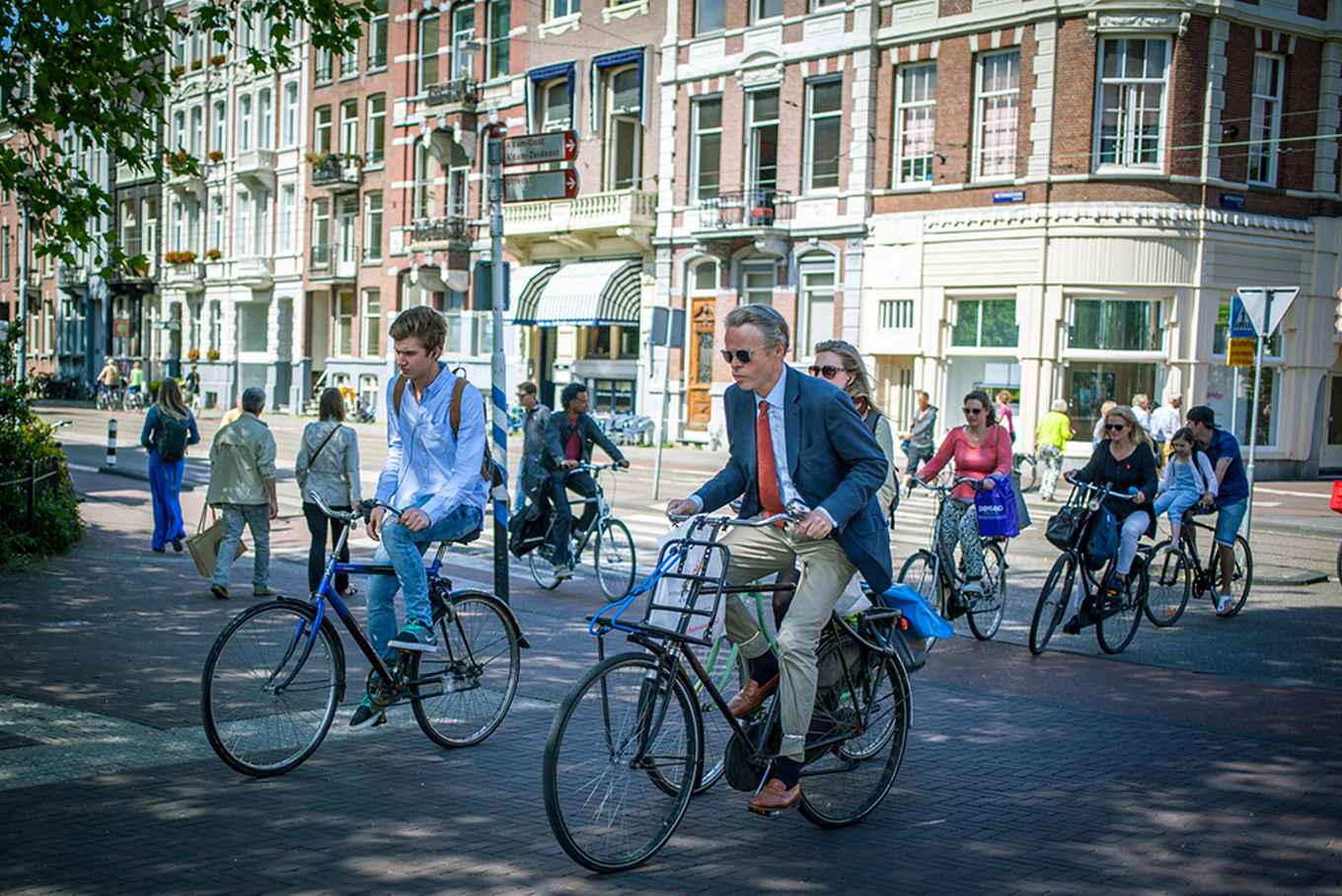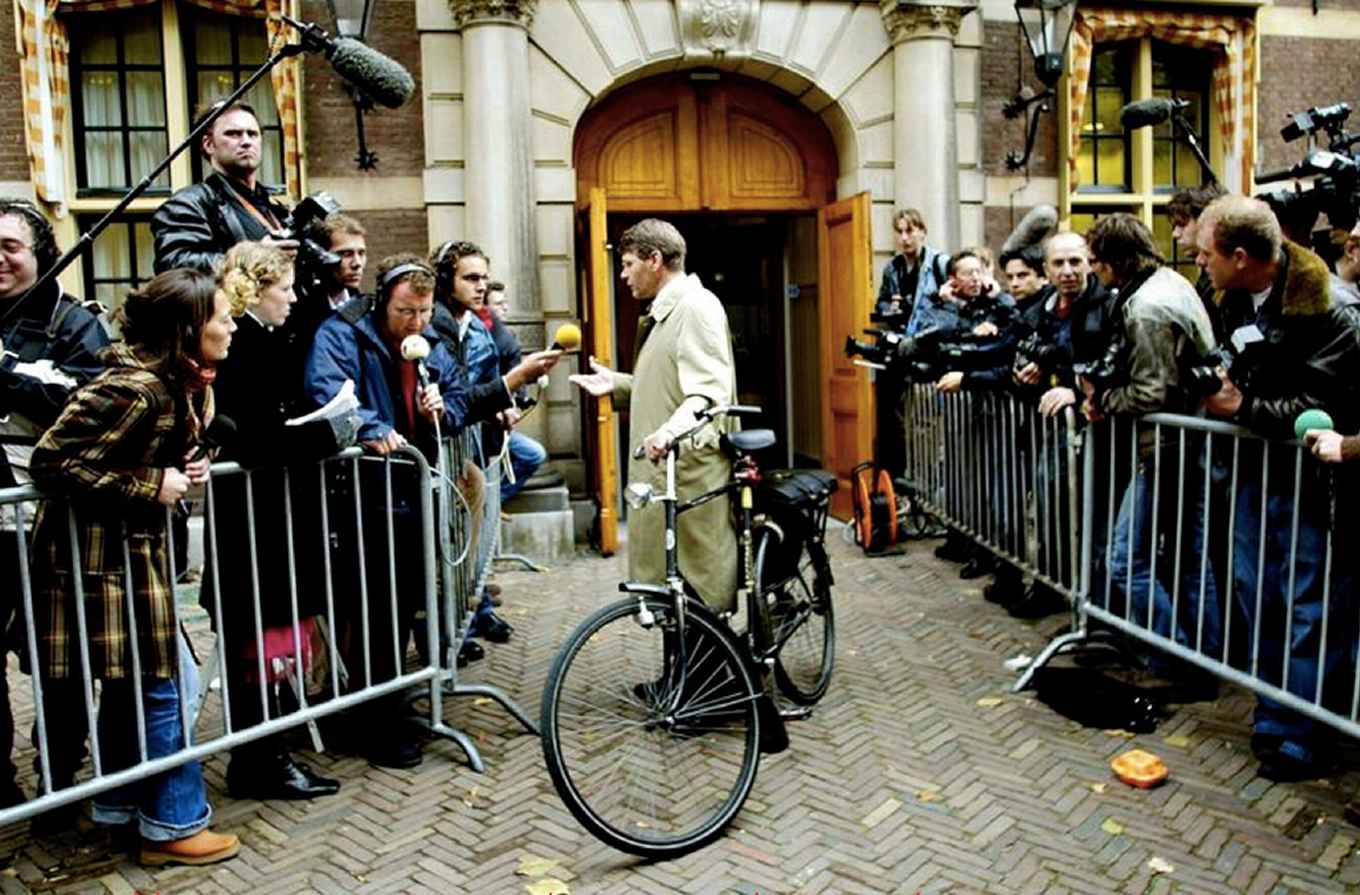The Handicap of a Head Start - by Dr Marco te Brömmelstroet
On the need for academic attention in the world’s leading cycling nation

So, although we are increasingly aware of the positive effects of cycling on the health, happiness and economic competitiveness of the Dutch we do not have a structured knowledge program, we do not travel the world in packs to share our knowledge, and we did not have academic efforts to improve our understanding of the success and fail factors that brought us here. We even feel awkward with all the attention of the many countries and cities that see us as their guiding light. Instead we should recognize that this gives us the moral obligation to not take our success for granted.
To illustrate this, I will focus here on the quite technical question of how we design our public space to accommodate for the unique numbers of cyclists that move through our cities. I will use the metaphors of cyclists as ‘Vaccuum Cleaners’, as ‘Flocks of Geese’ and as ‘Swarms of Starlings. And will close with what this means for a research agenda of the Centre for Urban Studies.
Cyclists as Vacuum Cleaners

In the Netherlands, there is a careless view on cycling. This can be illustrated by minister Donner, leaning relaxed on his classical Dutch bike while he talks to the press. He obviously does not fancy all this attention and just wants to ride home! Where Donner represents our Dutch attitude, the press exemplifies the massive international attention for our cycling culture. Some numbers that draw this attention are the approximately 18 million bikes, 80 % of the Dutch own one bike or more. 26% of all Dutch trips are done by bike (in some inner cities this goes up to more than 60%), which results in 4,5 billion trips annually. On an average weekday, 5 million cyclists make 14 million trips, although there are large social and spatial differences. Our 20 largest cities remove 150.000 wrongly parked bikes annually and Amsterdam fishes 10 thousands out of the canals.
In short:
- Dutch cycling is inspiring many, but mundane for the Dutch; it is not associated with a group, it has no significant sub cultures or own identity
- Almost everybody uses a bicycle to get from A to B, but just as easily switch to transit or the car when necessary. There are almost no Dutch ‘cyclists’
- The bicycle is a very useful add on that slightly improves our daily lives
To quote Mikael Colville-Andersen, we see our bicycles as we see our vacuum cleaners: we all have one, they are functional, but they are nothing special, right? You use it when needed and then put it back in the closet. Some would go as far as stating that only when you see bicycles in this way, you have a true cycling culture. But this status of mundane article for daily use can also be very dangerous. It creates a situation in which we forget to plan for it. It is our own elephant in the room. There are two main problems with this:
- Even in the Netherlands not everybody bikes and it is not mainstream everywhere. There are many vulnerable groups (elderly, children) and unwelcome spatial contexts (rural and many suburban places). There is still a dire need for active policy attention.
- The bicycle culture is not mechanical. Contrary to a vacuum cleaner it does deteriorate when it receives no attention. We have seen in the recent past that cycling rates can significantly decrease under consistent pressure by car-oriented policies. Cycling culture requires constant, consistent and strong care and attention.
Such attention also requires us to understand the logic and mechanisms of the cyclist in detail. Current design logic for public space and infrastructure in the Netherlands seems to lack such understanding. This is shortly discussed below.
Cyclists as Flock of Geese
Geese are graceful, large and cumbersome birds. They lack agility, and can therefore not cope with a lot of interaction on their long north- or southbound hauls in which should not spill any energy. This requires geese to have very clear and consistent rules for flying in groups: in a clear order, with a narrow range of speed and distances between two birds and with rules of who is flying in front.
This resembles general characteristics of car traffic. It is also this logic that is dominant in the design rules and guidelines for Dutch infrastructure. National guidelines that give clear and consistent rules of thumb for design choices. Not only for car infrastructure, but also when the bicycle is concerned: how should traffic lights be arranged, when, where and how are different traffic modes divided, what is the preferred width and colour of bicycle infrastructure under which conditions and the minimum radius for each corner.
Especially in the urban context, such guidelines are no longer in line with the new dynamics of rapidly changing traffic flows on the busy infrastructure. In Amsterdam, the designs of many intersections seem in direct conflict with the amounts and behaviour of pedestrians and cyclists. In many places they are now outnumbering car traffic by far. But it also seems that we cannot just reapply our guidelines to these new situation. Instead, a more radical revision is needed. To demonstrate that, I will use the third and final metaphor.
This must require huge computational powers on the individual level. For those that experienced cycling in such busy situations this is recognizable (and similar to what you can do in heavy pedestrian flows). You approach a crossing and within a split second you:
- know the position, direction and speed of tens of other cyclists pedestrians, mopeds, cars etc. This represents quite a range already.
- gain a lot of extra information from your peripheral vision: the sequence of the traffic light, the body language of the cyclists in front of you, the types of bicycles, the colors of bikes (in Amsterdam; if red it is a tourist), the color of the cars (white vans are notorious) and even the colour of number plates (blue means ca driver; be careful).
- translate this knowledge through heuristics into instantaneous manoeuvres to ensure a smooth trajectory across the intersection; slightly to the left to give space and flow to another cyclist, pressure of the pedals to pass just behind a pedestrian or STOP! because of an approaching taxi.
Just like a goose can hardly understand how the starlings do not constantly bump into each other, it is very hard to grasp this organized complexity from a car dominated perspective: “why don’t they wear helmets, why are they cycling contra-flow, why do they cut off corners or ignore red lights?” This is most visible in tourists that observe a typical Amsterdam intersection with their mouths wide open. With 4.5 billion bicycle trips annually, it is quite a feat that this high level of self-organisation leads to such little conflict. This is exactly what makes it so special!
We do not need to take a normative stance to this behaviour to argue that we need a much better understanding of what is going in, how cyclists organize this emergent complex, swarm-like choreographies. These are becoming so dominant, that we need to either cater for them or better understand how to influence them.
Making choices, observing and learning from deviating behaviour
New realities in our cities require new design choices for our public space and our infrastructure. To do so, we must critically assess the current logics and assess how it fits with these changing needs. We need to become aware that cyclists (and also pedestrians) cannot be seen as smaller versions of cars and therefore have a need for new and radically different metaphors. Otherwise we make crucial mistakes in transplanting solutions from the car domain onto this new urban mobility challenge, like Foster with his megalomaniac bicycle highways on stilts. We need to become more sensitive for the specifics of local context, which requires less modelling and more observation, less thinking big and more acting small and less rigidness and more flexibility and learning. We need to develop better insights and trust in the self-organising characteristics of the cyclists as long as the have enough space and enough numbers. And we need to become much more sensitive for disturbances to this intricate dance. We definitely need a more multidisciplinary take on all these challenges (think about the rise of the moped in Amsterdam for instance).
A central debate in all this is how do we deal with non-conformist behaviour? Do we punish it and force it back into the rigidness of our designs? Or do we accept that these designs and rules were also once developed and need to undergo constant rethinking? The question that is central for our cities and will be central in our new Urban Cycling Institute is: do we want to engineer our cities for flocks of geese or do we want to design our cities for swarms of starlings?
Marco te Brömmelstroet
Marco te Brömmelstroet is assistant professor in Urban Planning and member of the Centre for Urban Studies. He specialized in metropolitan transport planning, with a specific research focus on urban cycling and cycling behaviour. The Centre for Urban Studies recently launched the Urban Cycling Institute (UCI), an initiative that will be led and developed further by both Marco te Brömmelstroet and Willem Boterman. The newly established UCI is an interdisciplinary research platform with a scientific and policy-oriented agenda. For more information on the UCI, please visit http://uci.strikingly.com.